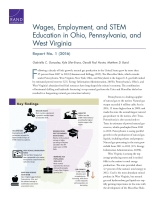| 来源类型 | Research Reports
|
| 规范类型 | 报告
|
| DOI | https://doi.org/10.7249/RR1357
|
| 来源ID | RR-1357-CHC
|
| Wages, Employment, and STEM Education in Ohio, Pennsylvania, and West Virginia: Report No. 1 (2016) |
| Gabriella C. Gonzalez; Kyle Siler-Evans; Gerald Paul Hunter; Matthew D. Baird
|
| 发表日期 | 2016
|
| 出版年 | 2016
|
| 页码 | 23
|
| 语种 | 英语
|
| 结论 |
API Regional Trends in the Working-Age Population and in Wages and Employment in Energy and Advanced Manufacturing Sectors- The API county with the greatest growth in working-age population was Monongalia County, West Virginia, which grew by 29.2 percent from 2000 to 2013. At this same time, the working-age population in the United States grew by 13.6 percent. In all but five counties of the API region, the size of the working-age population decreased.
- Median wages were relatively high in some suburban Pittsburgh areas but highest in portions of a West Virginia county that experienced high growth in its working-age population.
- The utilities industry was the STEM-related industry category that provided the highest median wages in the region.
- The occupations of engineering and architecture enjoyed the highest median wages of STEM-related occupations across all industries, but there was a wide range of median wages in the 27-county region.
- The number of regional jobs in STEM-related industries and occupations increased, while those in other industries decreased.
- West Virginia lagged behind Pennsylvania, Ohio, and the national average in mathematics and science assessment scores, with 76 percent of eighth graders scoring at basic or below, only 3 percent scoring advanced in mathematics, and more than three in four students scoring basic or below basic in science.
- Ohio and West Virginia had high school graduation rates comparable to the nation, while Pennsylvania outperformed the national average. Graduation rates in the three API states, as well as nationally, improved by 2 to 3.5 percentage points between 2010-2011 and 2012-2013.
- Ohio and Pennsylvania exceeded the nation in percentages of students gaining associate's degrees in STEM-related fields, while West Virginia trailed. All three states, and the nation, had roughly comparable percentages of students gaining bachelor's degrees in STEM-related fields.
|
| 主题 | Employment and Unemployment
; Energy
; Engineers and Engineering
; Ohio
; Pennsylvania
; STEM Education
; Wages and Compensation
; West Virginia
; Workforce Development
; Workforce Management
|
| URL | https://www.rand.org/pubs/research_reports/RR1357.html
|
| 来源智库 | RAND Corporation (United States)
|
| 引用统计 |
|
| 资源类型 | 智库出版物
|
| 条目标识符 | http://119.78.100.153/handle/2XGU8XDN/108181
|
推荐引用方式
GB/T 7714 |
Gabriella C. Gonzalez,Kyle Siler-Evans,Gerald Paul Hunter,et al. Wages, Employment, and STEM Education in Ohio, Pennsylvania, and West Virginia: Report No. 1 (2016). 2016.
|
|
文件名:
|
1510253730760.jpg
|
|
格式:
|
JPEG
|

|
文件名:
|
RAND_RR1357.pdf
|
|
格式:
|
Adobe PDF
|
除非特别说明,本系统中所有内容都受版权保护,并保留所有权利。